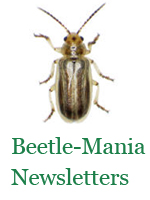Microlarinus lareynii (Jacquilin du Val)
[Coleoptera: Curculionidae]
Biology | History | Successes | Implementation | Host Range | Research | Literature | Links
Female weevils chew into the side of a young puncturevine bur, deposit eggs into the seed and seal it with fecal material. Females may deposit up to 324 eggs. Weevils grubs develop inside the seed and pupate therein. Each seed may produce 1-3 weevils. The life cycle from egg to adult requires about 25 days. Adult weevils may feed on the plant but do not cause appreciable damage to the plant. The number of generations per year depends on the climate. Adults overwinter.
The first release of Microlarinus lareynii for the biological control of puncturevine in the United States occurred in 1961. In the early summer months of 1961, Microlarinus lareynii seed weevils were released in Clark County, Nevada and Stanislaus County, California. Subsequent releases were made in Arizona, California, Colorado, Utah and Washington. The weevil became established in Arizona, California and Nevada but failed in Colorado, Washington and Utah. Today, puncturevine weevils are widely established throughout the United States.
In 1991, 28,000 weevils were released in the High Plains of Texas to augment the population in that region. In 1992, 22,000 weevils were also released in that area. Rummel and Arnold (1992) document the releases and infestation rates in the area.
In 1961, 250 weevils were released at sites near Amarillo and Big Spring, Texas. By 1963 the weevil was established in Big Spring but had failed in Amarillo. The weevil was again released at sites near Amarillo and Wellington, Texas. The weevil was once again unsuccessful in Amarillo but was established in Wellington. The lack of the weevils success in Amarillo was attributed to the extreme winter conditions and the inability of the weevil to adapt. By 1966, the puncturevine weevil had spread throughout West Texas and by the mid-1970’s puncturevine was no longer a weed pest in West Texas.
Both the seed weevil and the stem weevil for biological control of puncturevine are native insects of Europe, however the first releases of these species in the United States were imported from Italy. Weevil establishment is favored by warm temperature areas associated with mild winters. Sufficient puncturevine density is another factor necessary to support substantial weevil populations. The number of weevils released in an area for control of puncturevine is dependent on both these factors; the time of year and puncturevine densities. The number of weevils released is ordinarily between 250 and 1000 weevils
Microlarinus lareynii feeds on puncturevine, Tribulus terrestris, Jamaica feverplant, Tribulus cistoides and Kallstroemia spp.
The winter of 1983-84 was one of the harshest winters to date and most likely had a devastating effect on the weevil population. By 1987 puncturevine had returned as an economic pest in Texas. In 1991, 28,000 weevils were released in the High Plains of Texas to augment the population in that region. In 1992, 22,000 weevils were also released in that area. Rummel and Arnold (1992) document the releases and infestation rates in the area.
Daniels, N. E., and A. F. Wiese. 1967. Survival and Spread of the Puncturevine Seed Weevil in Texas. MP-827. Texas Agricultural Experiment Station. Texas A&M Univ. College Station, TX. 2 pp.
Goeden, R. D., and R. L. Kirkland. 1978. An Insecticidal-Check Study of the Biological Controlof Puncturevine (Tribulus terrestris L.) by Imported Weevils, Microlarinus lareynii and M. lypriformis (Col.: Curculionidae). Environ. Entomol. 7(3):349-354.
Kirkland, R. L., and R. D. Goeden. 1978. Biology of Microlarinus lareynii (Col.: Curculionidae) on Puncturevine in Southern California. Annals of the Entomol. Soc. Amer. 71:13-18.
Maddox, D. M. 1976. History of Weevils on Puncturevine in and Near the United States. Weed Science 24(4):414-419.
Rummel, D. R., and M. D. Arnold. 1992. Status of the Puncturevine Seed Weevil in the Texas Southern High Plains. Southwestern Entomologist. 17: 347-349.
Turner, C. E. 1995. Microlarinus lareynii. In Biological Control of Weeds in the West. Western Society of Weed Science.

